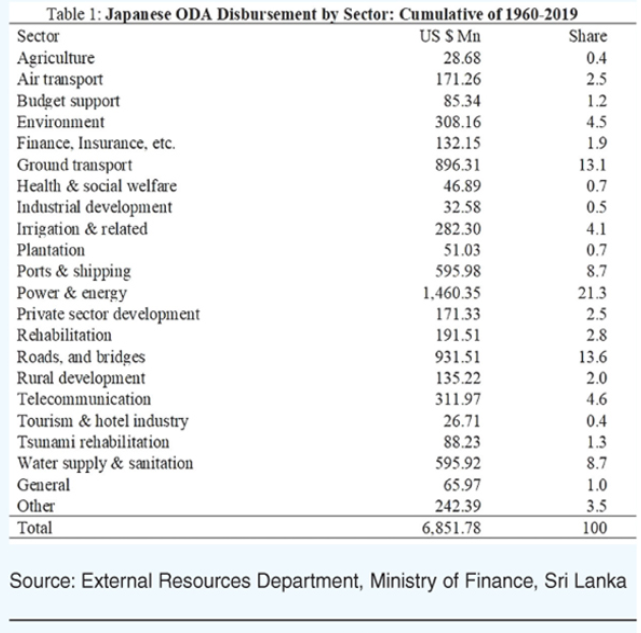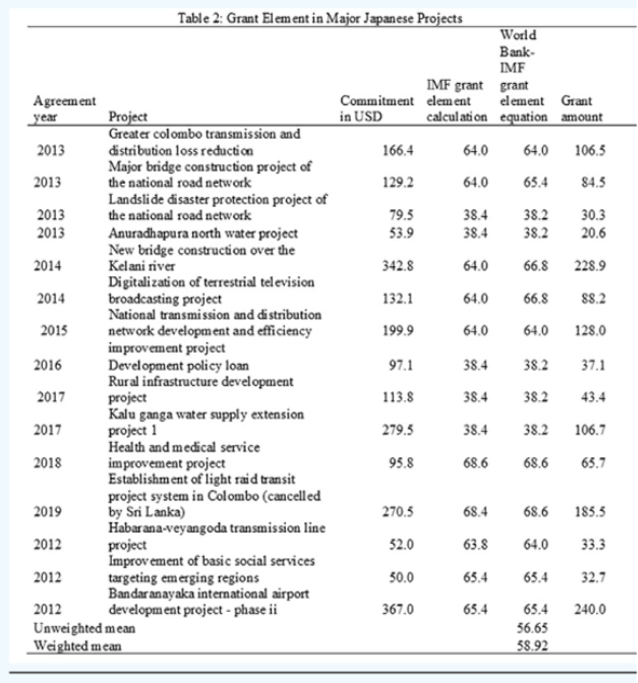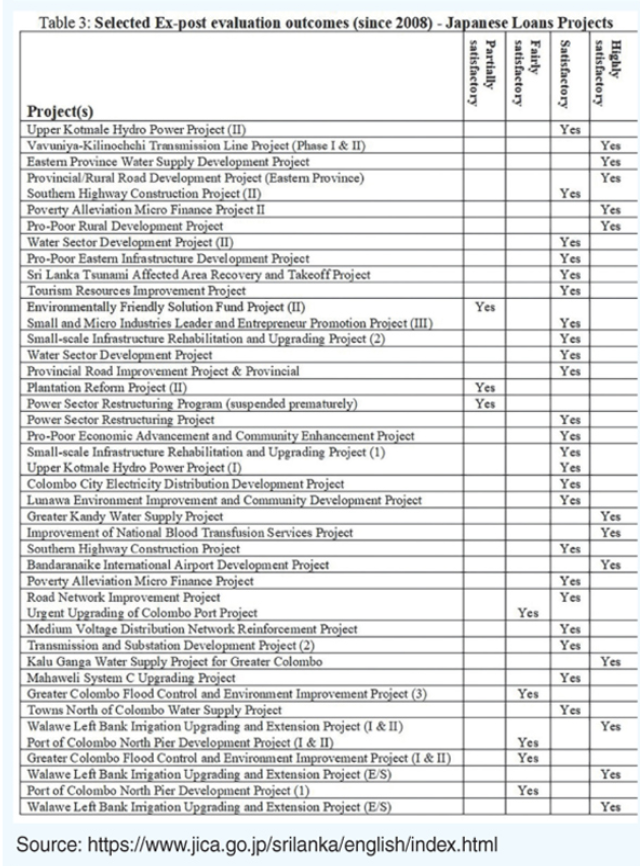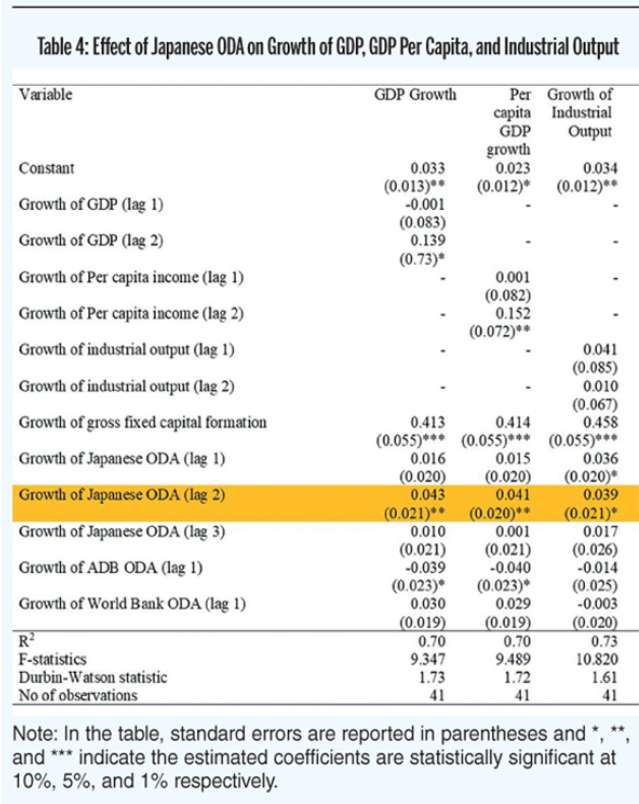Published in –DailyNews
The year 2021 marks the 70th Anniversary of the San Francisco Peace Conference in which the late former President (then Finance Minister) J.R. Jayewardene made a historic speech supporting Japan’s cause after the World War II, quoting from the words of the Lord Buddha, saying, “Hatred ceases not by hatred, but by love.” The journey of great friendship between Japan and Sri Lanka thus began, and in this commemorative year, the author aims to highlight how Japan’s support for “Quality Development” has played key role in achieving “Quality Growth” of Sri Lanka, while consolidating the bond of friendship between the two countries.
Japanese ODA and its approach
Japan vigorously assisted Sri Lanka’s self-help efforts for development following her union with the Colombo Plan in 1954. Starting with technical assistance in 1955, Japan expended her assistance, in terms of grants, loans, and technical assistance, to almost all key sectors in the economy of Sri Lanka and supported the development initiatives in all the provinces in the country. In implementing assistance, Japan is further strengthening partnerships with a wide range of institutions of the government of Sri Lanka, NGOs (Japanese NGOs, local NGOs and international NGOs) and academic research organizations to maximize synergetic and complementary effects. Japan continues to contribute to enhancing collaboration between the government and development partners, under the SDG framework. More importantly, Japan closely coordinates in particular with major donor countries and lending agencies, namely, the World Bank and the Asian Development Bank (ADB) to maximize development efforts. Japan has always given full consideration to crosscutting issues such as gender and environment, and made an effort to comprehensively introduce a gender perspective into each programme and project and tried to ensure that it contributes to environmental conservation. In particular, Japan has given due consideration to make sure that its assistance does not give rise to further economic, social and regional disparities in Sri Lanka, and rather provided assistance with a view to eliminating disparities, in the medium to longer term.
Relative size and sectoral coverage
Japan stresses that sustained economic growth is a prerequisite for poverty reduction, and Japan provides assistance for poverty reduction through economic growth as one of its goals. More specifically, Japan assists Sri Lanka’s efforts to accelerate economic growth. With respect to specific assistance, priority is placed on transport, electric power, agriculture, rural development and private sector development (including ICT and tourism). More importantly, Japan assisted Sri Lanka heavily in areas such as education, health and environment on the ground that such sectors play a key role in socio-economic and environmental wellbeing in the long run.
Japan also assisted in addressing water scarcity among the urban and rural poor communities. One of the other area of assistances is the improvement of good governance. In particular, Japan stressed on improvement of human rights, democracy, law and order and the judicial system since those are pivotal in the private sector led growth process in a country.
Interestingly, Sri Lanka has remained one of the priority countries for Japanese ODA during the last seven decades (see Figure 1). In relative terms, during 1970-2019, Japanese ODA accounted for nearly 5 percent of Gross Domestic Savings (GDS), 3 percent of Gross Fixed Capital Formation (GFCF), and 1 percent of Gross Domestic Products (GDP). Japan became Sri Lanka’s top bi-lateral donor during 1986-2005, and, during this period, Japanese ODA accounted for nearly 6 percent of GFCF and 2 percent of GDP. Out of the total Japanese ODA disbursed, over two-thirds channeled into economic infrastructure development; 26 percent in ground transport, 21 percent in power and energy, 9 percent in ports and shipping, 5 percent in telecommunications, and 4 percent on irrigation and related activities (see Table 1). In addition, Japanese ODA supported improving human resources development and the health sector in Sri Lanka. Moreover, development of the private sector, in particular small and medium enterprises, and poverty reduction have also been key areas for Japanese ODA. These clearly demonstrate that Japanese ODA to Sri Lanka has remained significant during the last seven decades.

 Key characteristics of Higher grant element
Key characteristics of Higher grant element
According to Organization for Economic Cooperation and Development (OECD), a bi-lateral finance assistance must contain a grant element of at least 25 percent to consider it as an ODA. One could employ formulas developed by the World Bank and International Monetary Fund
(IMF) to calculate the grant element of an ODA. The higher the grant element in an ODA, the lower the financial burden it carries to the recipient country when repayments are made. In particular, containing a higher grant element is invaluable for most developing countries to avoid repayment difficulties since their financial
capacities remain somewhat weaker while longer time is required to reap the economic benefit of ODA funded projects. In fact, economic and social infrastructure projects have relatively longer time horizons in delivering benefits.
An empirical study, carried out by the author, found that Japan has provided ODA to Sri Lanka on better terms than any other bi-lateral or multi-lateral organizations did. Lower interest rates associated with longer grace and maturity periods in Japanese ODA have resulted in a higher grant element. According to the estimation, based on World Bank and IMF grant element calculation formulas, on average, Japanese development loans obtained by Sri Lanka during the last two decades consisted of around 60 percent grant element (see Table 2).
These findings were further confirmed by a recent research conducted by the Verite Research in2020 (https://www.veriteresearch.org/publication/financing-infrastructure-the-…). According to Verite Research (2020), the grant element associated with Japanese loans ranges from 50 percent to 75 percent in 38 major Japanese development loans. According to Verite Research (2020), average weighted interest rate of 38 Japanese loans, obtained during 2005-2020, was 0.73 per annum, the lowest among all Sri Lanka’s donors. Most of the Japanese development loans contained around 10 to 15 years’ grace period and 30-40 years maturity period. As a result of lower interest rate and longer grace and maturity periods, Japanese development loans have never become financially burden for Sri Lanka. In recent years, many quarters in the society has been concerned over Sri Lanka’s growing public debt burden. Nevertheless, such concerns were hardly manifestations during the period in which Japan was the top bilateral donor. Possible reasons for the absence may be due to the fact that Japanese development loans were highly generous thereby not generating undue financial burden to the recipient country.
Lower life-cycle costs
One of the criticisms against foreign funded development projects is the higher costs associated with project preparation, designing, and construction. It is often alleged that uncompetitive practices and corruption and bribes lead to high project unit costs. In recent years, a few studies have found that project costs, in a comparable set-up, were lower in Japanese ODA funded project compared to that of the other bilateral and multilateral donors. In particular, Japanese ODA projects aim at minimizing life-cycle costs (construction, operation, maintenance, etc.) rather than just construction. The life-cycle costs approach allows policymakers to select “quality project” at lower costs rather than engaging in projects which are less costly at the stage of construction, but add heavy financial burden towards the operation and maintenance. The life-cycle cost approach has become highly useful for policymakers to get a sense of average cost in the long run.
Competitive procurement procedures
One of the key determinants of costs of donor funded projects is the type of procurement methods adopted by the donor. Broadly speaking, procurement methods, adopted by different donors, could be classified as follows: (a) internationally competitive bidding; (b) bidding restricted to suppliers from donor’s origin (partially competitive); (c) unsolicited proposals (uncompetitive); and (d) contractor pre-selected (uncompetitive). Internationally competitive bidding is the best practice while bidding restricted to suppliers from donor’s origin could be consider as the second best choice. Unsolicited project and contractor pre-selected approaches often cause project costs to balloon due to absence of a bidding process. What is an unsolicited project? Unsolicited projects are the ones that are proposed, developed, and implemented by the donors. Unsolicited projects are harmful due to (a) lack of transparency in selection and implementation of projects; (b) avoidance of competition; (c) avoidance of due diligence processes; and (d) opportunities for corruption and political patronage. Regardless of the pivotal role played by procurement methods in determining the overall project costs and, in turn, the financial burden for the recipient country, limited attempts have been made in understanding the procurement practices adopted by donors. Verite Research (2020) examined the procurement methods adopted in 50 major donor funded projects.
These projects were funded by both bilateral and multilateral donors. Interestingly, multilateral donors, the World Bank and Asian Development Bank, have adopted international bidding approach while Japan has adopted either the international bidding or bidding restricted to donor’s supplier practices. Accordingly, out of 13 considered, 7 development projects opted for international competitive bidding. Interestingly, none of the Japanese funded project has adopted highly uncompetitive unsolicited procurement method. The evidence shows that Japanese funded projects have adopted competitive bidding practices thereby making sure project costs are internationally comparable. Uncompetitive procurement practices cause countries to borrow more than the amount that actually costs a project and that, in turn, is an additional burden to the economy. Such practices could exacerbate debt burden if unsolicited projects account for a significant share of ODA received by a recipient country.

 Highly productive to the economy
Highly productive to the economy
Developing countries seek ODA for addressing key bottlenecks to growth and development. One of such bottleneck is the two gaps experienced by the developing countries. First, there is a gap between domestic savings and desired amount of investment in the economy. Second, there is a gap between foreign exchange earnings and expenses. Developing countries need to import most of the investment and intermediary goods which play a key role in the process of economic development. Another bottleneck is the limited supply of skilled human workforce in developing countries. It is expected that the ODA could effectively resolve these bottlenecks and unlock the growth and development potential in developing countries.
Evidence on the effectiveness of Japanese ODA in enhancing growth and development in Sri Lanka could be presented at two levels, namely at micro-level and macro-level. Micro-level evidence could be extracted from ex-post evaluation exercises undertaken by the Japanese International Cooperation Agency (JICA) and independent Country Assistance Evaluation reports commissioned to third parties.
Table 3 reports data related to findings of some of the Japanese ODA (loan) projects completed in recent years. Accordingly, nearly 77 percent of total development projects, funded via loans, were evaluated as ‘satisfactory’ and of which 38 percent of projects were evaluated as ‘highly satisfactory’. Interestingly, most of the projects which were carried out to improve or develop economic infrastructure reported ‘satisfactory’ status. The Country Assistance Evaluation reports also re-affirms that development project carried out under Japanese ODA delivered expected outcomes. Country Assistance Evaluation (2008) concluded:
“The contribution of Japan’s ODA to the development of economic infrastructure such as roads, electricity, water and sanitation was found to be highly satisfactory. Therefore, positive impacts are expected for the socio-economic development of targeted project areas.”
Similarly, Country Assistance Evaluation (2014) briefly summarized the findings of the evaluation as follows: “Overall, Japan’s assistance to Sri Lanka was characterized as very effective.”
An ex-post evaluation is done in assessing the project’s relevance, coherence, effectiveness, efficiency, impact, and sustainability. There is a well-established tradition in Japanese ODA agencies in carrying out ex-post evaluation exercises to determine to what extent the project achieved its initial objectives and to learn lessons for future aid operations. The findings imply Japanese ODA funded projects are not only relevant in the context of Sri Lanka’s national development objectives, but also have made a significant impact to the society. More importantly, the development projects have become sustainable.
At macro-level, researchers have investigated the impact of Japanese ODA on key economic variables such as GDP, GDS, industrial output, exports, and FDI. Interestingly, a number of empirical studies, both cross-country and country specific studies, have confirmed that Japanese ODA effectively enhances economic growth and development in developing countries.
The author examines the effect of Japanese ODA on growth of GDP, GDP per capita and industrial output for the period of 1975-2019. Findings are reported in Table 4. The estimated results indicate that there is a statistically meaningful positive relationship between the growth of Japanese ODA and Sri Lanka’s GDP growth during the study period. Moreover, growth of Japanese ODA positively relates with both per capita GDP growth and industrial output growth. Our results are in consistent with previous research (Momita, et. al., 2019, Kawasaki, 2004, Cooray, 2003). Momita, et. al., (2019) found, for a panel dataset of 117 countries, Japanese ODA is positively related with the growth of industrial output whereas Kawasaki (2004) found, for a set of six Asian countries, that Japanese ODA contributed to enhance GDP growth rate in recipient countries by around 0.6 to 1.6 per cent per annum. Similarly, Cooray (2003) found Japanese ODA is positively correlated with gross fixed capital formation in Sri Lanka during 1960-2000.
As previously mentioned, a greater share of Japanese ODA channeled into economic and social infrastructures developments; these included roads, bridges, power and energy, ports and airports, telecommunication, education and training, health, and water and sanitation. Our findings clearly indicated that such projects were carried out in the highly efficient manner and at lower costs. More importantly, development projects have become highly productive resulting in greater contribution to the economy and people. Quality is one of the cornerstones of any Japanese projects or services.
Conclusion
Japan has assisted Sri Lanka over the years to achieve her socio-economic development enjoyed by the current generation. Covering key economic sectors, Japan has provided ODA at a lower costs, with a higher grant element, within a competitive and transparent context. Japan has successfully funded a number of key development projects covering roads, power, transport, and education. Reflecting the unique feature of Japanese ODA, a greater majority of assistance has channeled into economic infrastructure development or improvements in the country. Our regression analysis clearly indicates that there is a strong positive relationship between Japanese ODA and economic growth and development in the country. Our findings are consistent with the findings of previous research studies. The findings imply that social and economic infrastructures developed with assistance of Japanese ODA have contributed to economic growth and development in the country. This impact was further supported through the micro-level evidence found in ex-post impact evaluations and third party impact evaluations. These evidences clearly indicate that Japanese ODA, with particular emphasis on “Quality Development” has contributed to promoting “Quality Growth” of Sri Lanka and “Quality Life” of Sri Lankan people over the last seven decades continuously.
